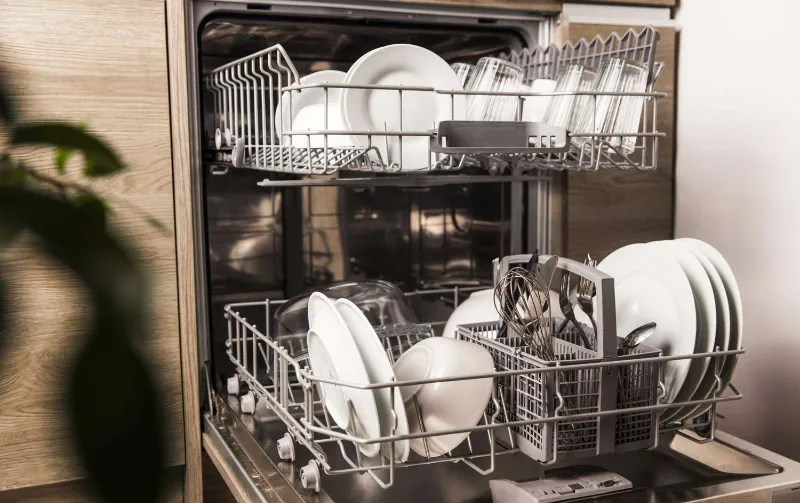You can lay a dishwasher on its side for transport or repair, but it’s imperative to avoid damaging internal components. Ensure the dishwasher drains completely to prevent water from leaking onto sensitive parts.
Transporting a dishwasher safely often involves maneuvering it through tight spaces or over longer distances.
Laying a dishwasher on its side might appear as a practical solution, especially when dealing with spatial constraints or needing to perform certain repairs.
Yet, it’s crucial to proceed with caution to preserve its functionality.
Before tilting your appliance, consult the manufacturer’s guide to avoid contravening any specific instructions regarding movement and storage.
Proper preparation, such as draining all water and securing loose components, further reduces the risk of damage.
Adhering to these guidelines not only extends the life of your dishwasher but also prevents costly repairs or replacements.
Remember, while it is technically possible to lay a dishwasher on its side, it’s a procedure that should be undertaken with the utmost care and preparation to ensure the continued efficiency of your appliance.

What Happens When You Lay A Dishwasher On Its Side?
Laying a dishwasher on its side might be necessary during transportation or installation, but it is important to understand the potential risks associated with this action.
Dishwashers contain essential electrical and mechanical components that are sensitive to orientation and movement.
The abrupt change in position can cause oil from the compressor to flow into the cooling lines, leading to ineffective cooling and potential damage.
Leakage is another significant risk when a dishwasher is not upright.
Seals and hoses may shift, which can compromise their integrity and lead to water damage.
Furthermore, delicate parts such as the water pump and sprayer arms can break or become misaligned, resulting in poor performance or the need for costly repairs.
| Potential Risk | Reason | Resulting Damage |
|---|---|---|
| Oil Migration | Compressor oil flows into cooling lines | Ineffective cooling, potential component failure |
| Leakage | Shifted seals and hoses | Water damage, repair costs |
| Physical Damage | Breakage of internal components like water pump | Poor dishwasher performance or inoperability |
Tips For Laying A Dishwasher On Its Side Safely
Transporting a dishwasher requires specific considerations to prevent damage.
Always consult the manufacturer’s guide before moving the appliance, as guidelines can vary.
Secure all loose parts within the dishwasher, including racks and utensil baskets, to avoid internal damage.
Taping the door shut will prevent it from swinging open.
To protect the dishwasher’s mechanics, it’s critical to keep it upright as much as possible.
However, if laying it on its side is unavoidable, place it on a soft surface, such as a blanket to prevent scratches or dents.
Always lay the dishwasher on its back to prevent putting pressure on the door and to avoid any potential strain on internal components.
| Step | Action |
|---|---|
| 1. | Lay on your back, not on sides |
| 2. | Tape door shut |
| 3. | Secure internal components |
| 4. | Transport upright when possible |
| 5. | When on the side, use a soft surface |
| 6. | Lay on your back, not on your sides |
After reinstalling the dishwasher, check for any loose connections or leaks.
Run a short cycle while the dishwasher is empty to ensure that all components are functioning correctly.
If you encounter any unusual noises or water on the floor, turn off the dishwasher and inspect the issue before proceeding with regular use.
Potential Alternatives To Laying A Dishwasher On Its Side
They can also offer advice on securing loose components and protecting delicate parts such as the motor and internal electronics.
Seeking professional help minimizes the risk of compromising the dishwasher’s functionality.
Frequently Asked Questions On Can You Lay Dishwasher On Its Side
Is Laying A Dishwasher On Its Side Safe?
Transporting a dishwasher on its side can be safe but is not recommended due to potential damage to mechanical components and the risk of leaks after installation.
What Precautions Should I Take?
Ensure that any loose components are secured, and consult the manufacturer’s manual for specific guidance on transportation or moving your model of dishwasher.
Can Laying It Cause Internal Damage?
Laying a dishwasher on its side can shift or damage internal components, risking malfunction or leakage upon reinstallation.
How Should A Dishwasher Be Transported?
A dishwasher is best transported in an upright position, firmly secured to prevent movement, and with adequate padding to protect it from impacts.
Conclusion
Transporting a dishwasher requires caution. It’s best to keep it upright, but laying it on its side is possible with preventive measures.
Prioritize securing any loose parts and follow manufacturer recommendations.
For transport ease without damage, following these tips ensures your dishwasher arrives safely for installation.
